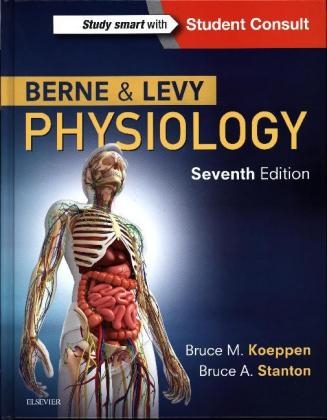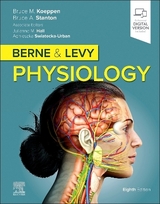
Berne & Levy Physiology
Elsevier - Health Sciences Division (Verlag)
978-0-323-39394-2 (ISBN)
- Titel erscheint in neuer Auflage
- Artikel merken
An organ system-based approach clearly describes all of the mechanisms that control and regulate bodily function.
Key experimental observations and examples provide a rich understanding of the body's dynamic processes.
Student Consult access allows you to view the complete contents of the book online, anywhere you go, perform quick searches, tap into relevant bonus content from other Student Consult titles, test your understanding with USMLE-style review questions, add your own notes and bookmarks, and much more.
More "In the Clinic" and "At the Molecular Level" boxes help readers better understand and apply what they've learned.
New coverage includes expanded discussions of gut and lung microbiota,; the limbic system; the hypthalamus and control of food intake; cardiac and vascular function curves during exercise; new aspects of lipid absorption; GI and metabolic consequences of bariatric surgery, the role of innate lymphoid cells in defense of the respiratory system, molecular mechanisms in normal and pathological muscle contraction; arterial pulse changes with age and the ankle-brachial index; regulation of the blood-brain barrier and cerebral blood flow; the regulation of phosphate; and thyroid hormone mechanism of action.
Each chapter begins with an all-new bulleted list of questions and ends with key concepts covered in that chapter.
Bruce Koeppen, founding dean of the Frank H. Netter MD School of Medicine at Quinnipiac, recently received two prestigious awards: honored by the Patient is U Foundation - a nonprofit that aims to encourage human communication in health care and support both patients and providers and the (LCME) Liaison Committee on Medical Education's 2019 Distinguished Service Award. Bruce Stanton received the Unsung Hero Award in 2019 from the Cystic Fibrosis Foundation. He played a key role in the development of Vertex modulators and is connected with sparking the creation of a Patient Registry which has had an enormous impact on the length and quality of lives in CF patients.
Section 1: Cellular Physiology
1. Principles of Cell and Membrane Function
2. Homeostasis: Volume and Composition of Body Fluid Compartments
3. Signal Transduction, Membrane Receptors, Second Messengers, and Regulation of Gene Expression
Section 2: The Nervous System
4. The Nervous System: Introduction to Cells and Systems
5. Generation and Conduction of Action Potentials
6. Synaptic Transmission
7. The Somatosensory System
8. The Special Senses
9. Organization of Motor Function
10. Higher Functions of the Nervous System
11. The Autonomic Nervous System and Its Central Control
Section 3: Muscle
12. Skeletal Muscle Physiology
13. Cardiac Muscle
14. Smooth Muscle
Section 4: The Cardiovascular System
15. Overview of Circulation
16. Elements of Cardiac Function
17. Properties of the Vasculature
18. Regulation of the Heart and Vasculature
19. Integrated Control of the Cardiovascular System
Section 5: The Respiratory System
20. Structure and Function of the Respiratory System
21. Static Lung and Chest Wall Mechanics
22. Dynamic Lung and Chest Wall Mechanics
23. Ventilation (V.), Perfusion (Q.), and V./Q. Relationships
24. Oxygen and Carbon Dioxide Transport
25. Control of Respiration
26. Nonrespiratory Functions of the Lung
Section 6: Gastrointestinal Physiology
27. Functional Anatomy and General Principles of Regulation in the Gastrointestinal Tract
28. The Cephalic, Oral, and Esophageal Phases of the Integrated Response to a Meal
29. The Gastric Phase of the Integrated Response to a Meal
30. The Small Intestinal Phase of the Integrated Response to a Meal
31. The Colonic Phase of the Integrated Response to a Meal
32. Transport and Metabolic Functions of the Liver
Section 7: The Renal System
33. Elements of Renal Function
34. Solute and Water Transport along the Nephron: Tubular Function
35. Control of Body Fluid Osmolality and Volume
36. Potassium, Calcium, and Phosphate Homeostasis
37. Role of the Kidneys in the Regulation of Acid-Base Balance
Section 8: The Endocrine and Reproductive Systems
38. Introduction to the Endocrine System
39. Hormonal Regulation of Energy Metabolism
40. Hormonal Regulation of Calcium and Phosphate Metabolism
41. The Hypothalamus and Pituitary Gland
42. The Thyroid Gland
43. The Adrenal Glands
44. The Male and Female Reproductive Systems
| Erscheinungsdatum | 06.04.2017 |
|---|---|
| Zusatzinfo | Approx. 975 illustrations (915 in full color); Illustrations |
| Verlagsort | Philadelphia |
| Sprache | englisch |
| Maße | 216 x 276 mm |
| Gewicht | 2310 g |
| Themenwelt | Studium ► 1. Studienabschnitt (Vorklinik) ► Physiologie |
| ISBN-10 | 0-323-39394-2 / 0323393942 |
| ISBN-13 | 978-0-323-39394-2 / 9780323393942 |
| Zustand | Neuware |
| Haben Sie eine Frage zum Produkt? |
aus dem Bereich



